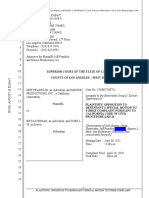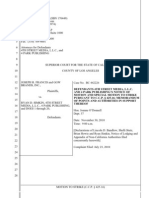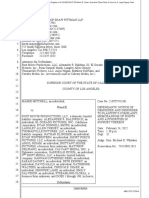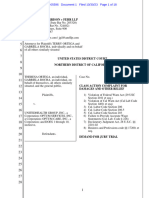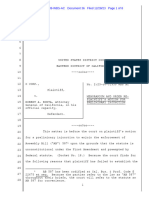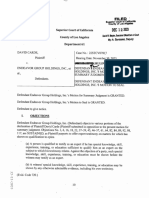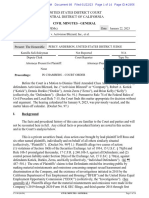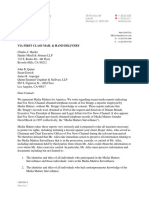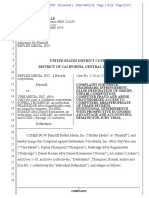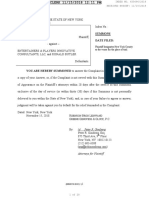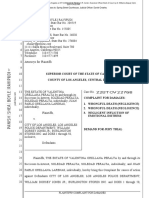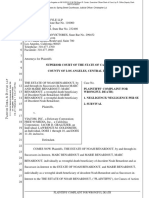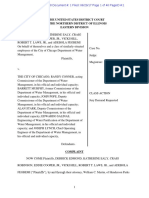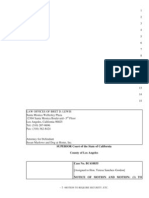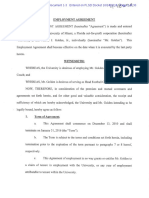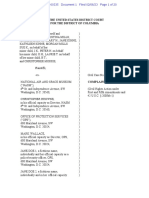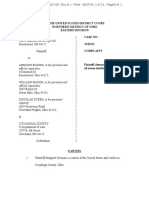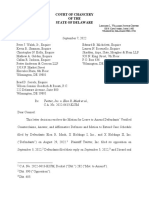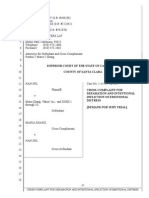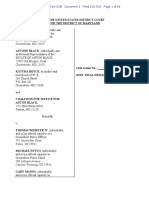0 ratings0% found this document useful (0 votes)
20K views21 pagesAMG v. McDonalds
order on anti-SLAPP
Uploaded by
THRCopyright
© © All Rights Reserved
We take content rights seriously. If you suspect this is your content, claim it here.
Available Formats
Download as PDF or read online on Scribd
0 ratings0% found this document useful (0 votes)
20K views21 pagesAMG v. McDonalds
order on anti-SLAPP
Uploaded by
THRCopyright
© © All Rights Reserved
We take content rights seriously. If you suspect this is your content, claim it here.
Available Formats
Download as PDF or read online on Scribd
You are on page 1/ 21
Superior Court of California FEB 02 2024
County of Los Angeles oe sen ai ast
By: J. Marquez, Deputy
Case No.: 23STCV 10045
WEATHER GROUP, LLC, et al.;.
DEPARTMENT 45
Plaintiffs,
vs. een CtTORDER
MCDONALD'S USA, LLC;
Action Filed: 05/04/23
Trial Date: None Set
Defendant.
Hearing date: February 2, 2024
Moving Party: Defendant McDonald’s USA, LLC
Responding Party: Plaintiffs Weather Group, LLC and Entertainment Studios Networks, Inc.
(1) Special Motion to Strike (Anti-SLAPP Motion)
(2) Demurrer to Complaint
‘The court considered the moving, opposition, and reply papers.
The court GRANTS Defendant's special motion to strike under CCP § 425.16 as to the
first and only cause of action of the Complaint,
Defendant's demurrer to the Complaint is MOOT.
Background
Plaintiffs Weather Group, LLC and Plaintiff Entertainment Studios Networks, Inc. filed
this action on May 4, 2023 against defendant McDonald's USA, LLC, alleging a cause of action
for Fraud - False Promise (Civ. Code § 1711).
oy The Complaint alleges the following: Prominent American corporations promised to take
an active role in remedying racial injustice after George Floyd’s murder ignited nationwide
protests. (Compl., { 1.) Defendant only pledged $1 million despite
one of the largest public
corporations in America. (Id. at { 2.) Plaintiffs are part of a conglomerate of related media
companies (“AMG" or “Allen Media Group”), all owned by Byron Allen, an African American
entrepreneur. (Id. at 4.) AMG is by far the largest African American-owned media company in
the country, with Plaintiffs representing over 90 percent of that category. (Id. at {9.) Allen
created the Black Owned Media Matters movement after the George Floyd murder to address
racial discrimination and systemic racism in media. (Id. at { 5.) AMG informed Defendant in
March 2021 that AMG had been victims of racial discrimination in contracting in violation of 42
U.S.C. § 1981. (Id. at] 6.) Defendant announced its “Four-Year Plan” in May 2021 to deflect
from these serious allegations. (/d. at J 7.) Defendant's plan included a commitment to increase
its spending with Black Owned Media from two to five percent by 2024. (Id.)
In reliance on Defendant's commitment, Plaintiffs spent considerable time and effort to
put together a proposal for Defendant to advertise across their portfolio. (Jd. at [ 9.) Defendant
rebuffed Plaintiffs and proposed to spend only a tiny fraction of its advertising budget on
Plaintiffs’ properties. (id. at | 10.) Defendant's allocation left it well short of its public
commitment. (Id.) In 2021 and afterwards, Defendant was not spending anywhere close to two
percent of its national advertising budget on Black Owned Media under any definition. (Id. at {
12.) Defendant should now be spending under its “four-year plan” four percent of its national
advertising budget on Black Owned Media, but Defendant is nowhere near meeting that
commitment. (Id. at { 13.)
Defendant filed a special motion to strike (“anti-SLAPP motion”) with respect to the
Complaint on June 22, 2023. Plaintiffs filed an opposition on December 1, 2023. Defendant
replied on December 7, 2023.
Defendant filed a demurrer to the Complaint on June 20, 2023. Plaintiffs filed an
opposition on December 1, 2023, Defendant replied on December 7, 2023.
Legal Standard
Anti-SLAPP Motion
Defendant filed a special motion to strike under CCP § 425.16, which is also known as
the anti-SLAPP (“strategic lawsuit against public participation”) statute.
“The anti-SLAPP procedures are designed to shield a defendant’s constitutionally
protected conduct from the undue burden of frivolous litigation.” (Baral v. Schnitt (2016) 1
Cal. Sth 376, 393.) “The anti-SLAPP statute does not insulate defendants from any liability for
claims arising from the protected rights of petition or speech. It only provides a procedure for
weeding out, at an early stage, meritless claims arising from protected activity.” (Id. at 384.)
“Resolution of an anti-SLAPP motion involves two steps. First, the defendant must
establish that the challenged claim arises from activity protected by section 425.16. If the
defendant makes the required showing, the burden shifts to the plaintiff to demonstrate the merit
of the claim by establishing a probability of success.” (Baral, supra, | Cal.Sth at 384, citation
omitted.) The California Supreme Court has “described this second step as a ‘summary-
judgment-like procedure,’ The court does not weigh evidence or resolve conflicting factual
claims. Its inquiry is limited to whether the plaintiff has stated a legally sufficient claim and
made a prima facie factual showing sufficient to sustain a favorable judgment. It accepts the
plaintiff's evidence as true, and evaluates the defendant’s showing only to determine if it defeats
the plaintiff's claim as a matter of law. *{C]laims with the requisite minimal merit may proceed.’
” (Id. at 384-385, citations omitted.)
Demurrer
When considering demurrers, courts read the allegations liberally and in context. (Taylor
v. City of Los Angeles Dept. of Water and Power (2006) 144 Cal.App.4th 1216, 1228.) “A
demurrer tests the pleadings alone and not the evidence or other extrinsic matters. Therefore, it
i 3
@
3S
3
lies only where the defects appear on the face of the pleading or are judicially noticed.” (SKF
Farms v, Superior Court (1984) 153 Cal. App.34 902, 905.) “The only issue involved in a
demurrer hearing is whether the complaint, as it stands, unconnected with extraneous matters,
states a cause of action.” (Hahn v. Mirda (2007) 147 Cal.App.4th 740, 747.)
Evidentiary Objections
ffs’ Obj S
The court rules on Plaintiffs’ evidentiary objections in support of their opposition to
Defendant's anti-SLAPP motion as follows:
L
Karen Ding’s Declaration in Support of Defendant’s Reply in Support of Its Anti-
SLAPP Motion: SUSTAINED ~ Plaintiffs object to this evidence on the ground that
it is new evidence accompanying the Reply. Defendant asserts that the exhibit
attached to this declaration could not be included in the moving papers because it was
previously subject to a protective order. New evidence generally cannot accompany
reply papers, but this is a matter that rests within the trial court’s discretion. (See Jay
v. Mahaffey (2013) 218 Cal. App.4th 1522, 1537-38 [The general rule of motion
practice, which applies here, is that new evidence is not permitted with reply
apers.”}; San Diego Watercrafts, Inc. v. Wells Fargo Bank, N.A. (2002) 102
Cal.App.4th 308, 316 [Whether to consider evidence not referenced in the moving
party’s separate statement rests with the sound discretion of the trial court... ..”].)
Since Plaintiffs could not respond to this new evidence and it is ultimately not
determinative of the outcome of the ruling, the court finds it is proper to sustain
Plaintiffs’ objection.
Defendant’s Objections
The court rules on Defendant's evidentiary objections in support of its anti-SLAPP
motion as follows:
Schecter Declaration, Ex. C (Letter from Plaintiffs’ counsel to McDonald's):
SUSTAINED - Hearsay.
2. Schecter Declaration, Ex. D (Restaurant Business Online aticley: SUSTAINED ~
Hearsay.
3. Schecter Declaration, Ex. E (Sonnenfeld article): SUSTAINED ~ Hearsay.
4. Galatt Declaration, J 11: OVERRULED.
5. Galatt Declaration, $] 12-18: OVERRULED.
6. Galatt Declaration, 4 25: OVERRULED.
7. Galatt Declaration, {9 26-28: OVERRULED
8. Galatt Declaration, $ 32-34: OVERRULED
9. Galatt Declaration, $M] 35-36, 38-40: OVERRULED.
Discussion
Anti-SLAPP Mc
Defendant McDonald’s USA, LLC moves to strike, pursuant to CCP § 425.16, the first
and only cause of action for fraud — false promise (Civ. Code § 1711) of the Complaint, filed by
plaintiffs Weather Group, LLC and Plaintiff Entertainment Studios Networks, Inc. Defendant
contends Plaintiffs’ cause of action arises out of protected activity because it is based on
Defendant's May 2021 press release describing Defendant's goal to increase its national
advertising spending on Black-owned businesses, which was part of a national dialogue about
racial inequality and systemic racism, Defendant argues the press release is a public statement
regarding an issue of public interest under CCP § 425,16(e)(3) and that the “commercial speech”
exemption does not apply. Defendant asserts Plaintiffs cannot show a probability of prevailing
con the merits because Plaintiffs cannot prove an actionable false promise, that Defendant did not
perform or did not intend to perform, that Defendant intended to induce reliance, that Plaintiffs
reasonably relied on the press releases, and that Plaintiffs suffered damages proximately caused
by the alleged false promise
Plaintifis contend Defendant's press release falls within the “commercial speech”
‘exemption and is not protected activity because it made a factual representation about
Defendant’s advertising operations to increase the sales of its goods. Plaintiff argues that
statements about business operations can constitute “commercial speech” even when public
interest issues are involved and that Defendant cannot insulate itself simply by maintaining its
statements contributed to the national discussion about race. Plaintiffs assert, even if Defendant's
statements are protected, Plaintiffs can show a probability of prevailing on the merits of their
claim because Defendant's promise was false when made based on Defendant's own data.
Plaintiffs maintain that Defendant's statements were intended to induce reliance by the public
and that Plaintiffs actually and justifiably relied on Defendant's false representations by spending
considerable time and effort on investment proposals to Defendant.
I. Conduct in Furtherance of Right of Petition or Free Speech
CCP § 425.16(e) states: “As used in this section, ‘act in furtherance of a person's right of
petition or free speech under the United States or California Constitution in connection with a
Public issue’ includes: (1) any written or oral statement or writing made before a legislative,
executive, or judicial proceeding, or any other official proceeding authorized by law, (2) any
written or oral statement or writing made in connection with an issue under consideration or
*S review by a legislative, executive, or judicial body, or any other official proceeding authorized
by law, (3) any written or oral statement or writing made in a place open to the public or a public
forum in connection with an issue of public interest, or (4) any other conduct in furtherance of
the exer
of the constitutional right of petition or the constitutional right of free speech in
connection with a public issue or an issue of public interest.”
“[T]he statute requires the defendant to make a prima facie showing the plaintiff's suit
arises ‘from any act of [defendant] in furtherance of [defendant's] right of petition or free speech
under the United States or California Constitution in connection with a public issue.’ (§ 425.16,
subd. (b).) The defendant may meet this burden by showing the act which forms the basis for the
plaintiff's cause of action was a written or oral statement made before a legislative, executive, or
judicial proceeding; or such a statement in connection with an issue under consideration or
review by a legislative, executive, or judicial body; or such a statement was made in a place open
to the public or a public forum in connection with an issue of public interest. (§ 425.16, subd.
(©).)” (Wilcox v. Superior Court (1994) 27 Cal. App.Ath 809, 820, disapproved on other grounds
by Equilon Enterprises v. Consumer Cause, Inc. (2002) 29, Cal.4th 53.) “The Supreme court has
clarified that ‘arising from’ means ‘based on.’ (Citation.] This element of the first step of the
anti-SLAPP analysis is sometimes referred to as the ‘nexus’ requirement. [Citations.] Conduct
constitutes ‘protected activity,’ if it falls within one of the categories set out in section 425.16,
subdivision (¢).” (Laker v. Board of Trustees of California State University (2019) 32
Cal. App.Sth 745, 760.)
a. Public Statement Regarding an Issue of Public Statement
The statements at issue ii
this matter are those made in Defendant's press release on May
20, 2021, which states, in relevant part:
McDonald's USA today announced bold new investments to further reflect its
diverse customers, crew members and communities in its marketing.
Over the next four years, the company and Owner/Operators are accelerating the
allocation of advertising dollars to diverse-owned media companies, production
houses and content creators. McDonald's total investment in diverse-owned
partners — including Black, Hispanic, Asian Pacific American, Women and
LGBTQ-owned platforms — will more than double, moving from 4% to 10% of
national advertising spend between 2021 and 2024. Spend with Black-owned
properties, specifically, will increase from 2% to 5% of national advertising spend
over this time period.
(Galatt Decl., 25, Exh. A, p. 1.)
“In deciding whether the ‘arising from’ requirement is met, a court considers ‘the
pleadings, and supporting and opposing affidavits stating the facts upon which the liability or
defense is based.’ ” (City of Cotati v. Cashman (2002) 29 Cal.4th 69, 79, quoting CCP §
425.15(b)(2).) In anti-SLAPP analysis, the plaintiff's pleaded facts are accepted as true. (See
Central Valley Hospitalists v. Dignity Health (2018) 19 Cal.App.Sth 203, 217 (“And we accept
as true CVH's pleaded facts.”].) “A plaintiff's complaint ultimately defines the contours of the
claims.” (Bel Air Internet, LLC v. Morales (2018) 20 Cal.App.Sth 924, 936.) “As the Supreme
Court earlier instructed, at this first step of the anti-SLAPP analysis, ‘the moving defendant bears
the burden of identifying all allegations of protected activity, and the claims for relief supported
by them.” [Citation.]” (Central Valley Hospitalists, supra, 19 Cal.App.Sth at 217, italics in
original, quoting Baral, supra, | Cal.Sth at 396.)
The Complaint alleges “McDonalds stated in 2021 that it was spending 2% of its
national advertising budget on Black Owned Media, which was a lie, and it committed that the
spend would reach 5% by 2024.” (Compl., { 11.) Plaintiffs allege “McDonald’s made a material
misrepresentation when it stated that it would increase its spend with Black Owned Media from
2% im 2021 to 5% in 2024.” (Id. at 4 59.) The Complaint alleges “McDonald’s made this promise
with no intention to honor it” and that “McDonald’s intended to defraud the general public, its
shareholders and investors, the government, and Black Owned Media, including Plaintiffs.” (Id.
at {{ 60-61.)
Here, it does not appear Plaintiffs dispute that Defendant's May 20, 2021 press release
‘was a public statement made in connection with a public issue, The Complaint itself alleges that,
“[alfter the murder of George Floyd ignited nationwide protests, prominent American
corporations promised to take an active role in remedying racial injustice.” (Compl., { 1.)
Plaintiffs assert in their Opposition that “[Defendant’s] promise, announced on McDonald’s,
website, was a result of outrage over the death of George Floyd and a broad reckoning about
racial injustice that swept the country.” (Opposition, 5:6-8.) Further, Plaintiffs argue Defendant's
statements in its press release may constitute “commercial speech” even if when public interest
issues are involved, (Id. at 15:8-22.)
In addition, it does not appear Plaintiffs dispute that th
use of action arises out of
Defendant's May 20, 2021 press release statements, Plaintiffs’ allegations indicate Defendant
made a material misrepresentation when Defendant stated in its May 20, 2021 press release that
it will increase its advertising spending on Black Owned Media from two percent in 2021 to five
percent in 2024. (See Compl. #4 7, 59.) Plaintiffs allege Defendant intended to defraud the
general public and Black Owned Media, including Plaintiffs. (Id. at { 61.) It is apparent from
Plaintiffs’ allegations and the evidence presented that Plaintiffs’ cause of action arises from the
statements in Defendant's May 20, 2021 press release.
Under CCP §§ 425.16(€)(3) and (4), protected activity includes “any written or oral
statement or writing made in a place open to the public or a public forum in connection with an
issue of public interest”; or “any other conduct in furtherance of the exercise of the constitutional
right of petition or the constitutional right of free speech in connection with a public issue or an
issue of public interest.” Despite Defendant's press release being written public statements in
connection with a public issue or an issue of public interest, Plaintiffs maintain the statements are
nevertheless unprotected because they fall within the “commercial speech” exemption of the
LAPP statute. Accordingly, the court proceeds to consider whether the May 20, 2021 press
release falls within the “commercial speech” exemption of the anti-SLAPP statute.
b. “Commercial Speech” Excemption
“The commercial speech exemption, like the public interest exemption, ‘is a statutory
exemption to section 425.16" and ‘should be narrowly construed.’ [Citations.}" (Simpson Strong-
Tie Co., Inc. v. Gore (2010) 49 Cal.4th 12, 22.) This exemption is found in CCP § 425.17(¢),
which states:
(©) Section 425.16 does not apply to any cause of action brought against a person
primarily engaged in the business of selling or leasing goods or services,
including, but not limited to, insurance, securities, or financial instruments,
arising from any statement or conduct by that person if both of the following
conditions exist:
(1) The statement or conduct consists of representations of fact about that
Person’s or a business competitor's business operations, goods, or
services, that is made for the purpose of obtaining approval for,
promoting, or securing sales or leases of, or commercial transactions
in, the person’s goods or services, or the statement or conduct was made
in the course of delivering the person’s goods or services.
(2) The intended audience is an actual or potential buyer or customer, or a
person likely to repeat the statement to, or otherwise influence, an actual
or potential buyer or customer, or the statement or conduct arose out of or
within the context of a regulatory approval process, proceeding, or
investigation, except where the statement or conduct was made by a
telephone corporation in the course of a proceeding before the California
Public Utilities Commission and is the subject of a lawsuit brought by a
competitor, notwithstanding that the conduct or statement concerns an
important public issue.
(Emphasis added.)
10
The court does not find that the “commercial speech” exemption applies here. The plain
language of the statute indicates that the statement at issue must be “made for the purpose of
obtaining approval for, promoting, or securing sales or leases of, or commercial transactions in,
the person’s goods or services. ...” (CCP § 425.17(¢)(1), emphasis added.) Nowhere in the May
20, 2021 press release does it mention anything about Defendant's goods or services.
Specifically, the press release mentions nothing regarding any of Defendant's food products. The
press release also does not connect Defendant's stated commitment to increase advertising
dollars to diverse-owned companies with Defendant’s own products or services. Plaintiffs fail to
show present any evidence establishing a connection between Defendant's press release
statements and its food products.
Plaintiffs maintain that Defendant's press release is connected to its goods because
Defendant knows diversity initiatives are important to consumers and can lead to increased profit
margi
Plaintiffs present a publication from Defendant's website titled “2022-2023 Global
Diversity, Equity and Inclusion Report.” (Schecter Decl., 2, Exh. A.) Plaintiffs point to
statements in this publication that state:
Throughout our history, we have sought to embed diversity, equity and inclusion
into every layer of our System and foundation. We do this because it’s good for
business, it's the right thing to do, and because it enables us to deliver inclusive
experiences people expect and love from McDonald’s.
(id., Exh. A, p. 4. [2022-23 Publication, p. 3].)
Plaintiffs fail to show that such broad statements about diversity initiatives being “good
for business” are sufficient to show Defendant made its May 20, 2021 press release “for the
purpose of obtaining approval for, promoting, or securing sales or leases of, or commercial
transactions in” Defendant's food products. Being “good for business” can mean any number of
things, such as establishing goodwill, rather than specifically promoting or securing the sales of
ul
Defendant's food products. Plaintiffs appear to suggest that even a business's statements made to
establish goodwill are sufficient to fall within the “commercial speech” exemption. Plaintiffs
argue: “The goal of the Promise was to avoid negative press from a high-profile racial
discrimination lawsuit and to convince actual and potential customers that .. . [Defendant] is a
company deserving of their business. (Citation.] Similarly, Nike [in Kasky v. Nike (2002) 27
Cal.4th 939 (Kasky)] made the statements at issue to convince actual and potential customers
that, because Nike was committed to fair labor practices, Nike was deserving of their business.
As the Kasky court found these statements to be examples of ‘commercial speech,” so too should
this Court ....” (Opposition, 10:14-21.)
The court notes that Kasky is not an anti-SLAPP case and mentions nothing about CCP §
425.17(c) and the “commercial speech” exemption. Accordingly, court finds that Plaintiffs
reliance on Kasky to draw conclusions on the “commercial speech” exemption in CCP §
425.17(¢) in this anti-SLAPP matter is misplaced. The Court of Appeal has drawn the same
conclusion, indicating that “Kasky v. Nike, Inc. (2002) 27 Cal.4th 939, 119 Cal.Rptr.2d 296, 45
P.3d 243, does not involve a special motion to strike under section 425.16 and therefore is not
helpful to appellant on the issue of whether this action comes within the anti-SLAPP statute.”
(Kronemyer v. Internet Movie Database Inc. (2007) 150 Cal.App.4th 941, 948.)
Further, the plain language of the statute states that the exemption applies when the
statement at issue consists of “representations of fact about that person’s or a business
competitor's business operations, goods, or services.” (See CCP § 425.17(c)(1).) The Court of
Appeal in Navarro v. IHOP Properties, Inc. (2005) 134 Cal. App.4th 834 (“Navarro”) expressly
held that “[a] promise is not a representation of fact, but an agreement to take certain actions in
the future.” (Id. at 841.) Plaintiffs attempt to distinguish Navarro by asserting that the decision
turned on the fact that the promises there were not related or made to induce a commercial
12
transaction. (Opposition, 12:3-8.) However, this argument does not address or refute the Court of
Appeal’s conclusion that a promise is not a representation of fact under the anti-SLAPP statute.
In addition, as discussed above, the “commercial speech” is to be “narrowly construed.”
(Simpson Strong-Tie Co., Inc., supra, 49 Cal.4th at 22.) Consistent with this principle, the
California Supreme Court stated that “the language of section 425.17, subdivision (c) and
subsequent case law indicate that the provision exempts ‘only a subset of commercial
speech’—specifically, comparative advertising.” (FilmOn.com Inc. v. DoubleVerify Inc.
(2019) 7 Cal.Sth 133, 147 (FilmOn.com Inc.), emphasis added.) None of the evidence presented
shows Defendant’s May 20, 2021 press release was an advertisement for its products. Plaintiffs
do not argue that the press release was an advertisement. As discussed above, the press release
does not even mention any of Defendant's food products. Plaintiffs fail to provide evidence
demonstrating that Defendant issued the press release as an advertisement promoting or securing,
the sales of Defendant's food products. Given the narrow construction of the “commercial
speech” exemption, as discussed in FilmOn.com Inc., the court finds Plaintiffs do not establish
that the May 20, 2021 press release is unprotected “commercial speech” under the anti-SLAPP
statute,
Il. Probability of Prevailing on the Merits
Since Defendant meets its burden of showing that the alleged statements or conduct in
Plaintiffs’ first and only cause of action is protected under the anti-SLAPP statute, the burden
now shifts to Plaintiffs to establish by competent and admissible evidence that they have a
probability of prevailing on the merits of their claim, “{T]he plaintiff ‘must demonstrate that the
complaint is both legally sufficient and supported by a sufficient prima facie showing of facts to
sustain a favorable judgment if the evidence submitted by the plaintiff is credited.’ ” (Wilson v.
1B
a
i
Parker, Covert & Chidester (2002) 28 Cal 4th 811, 821, quoting Matson v. Dvorak (1995) 40
Cal. App.4th 539, 548.)
Defendants contend Plaintiffs cannot establish a probability of prevailing on the merits of
their claim because they cannot show (1) a clear, unambiguous promise Defendant made to
Plaintiffs; (2) that Defendant did not perform on any promise; (3) that Defendant did not intend
to perform on any promise at the time it was made; (4) that Defendant made any promise with an
intent to induce reliance; (5) that Plaintiffs reasonably relied on the press release; and (6) that
Plaintiffs suffered any damages proximately caused by the alleged false promise.
Plaintiffs contend that they have a probability of prevailing on the merits of their claim
because they can show (1) Defendant made a knowingly false representation in its promise based
on Defendant's own data; (2) Defendant intended for its promise to induce reliance since
Defendant's goal was to promote the sales of its goods and to appease other Black Owned
Media, its own shareholders, regulators, and others in the hopes that a mass boycott would be
avoided; and (3) Plaintiffs reasonably relied on Defendant's false representations to their
detriment since other major corporations were making real promises to advance racial equity at
that time and Plaintiffs sustained out-of-pocket damages on putting together proposals to
Defendant.
“The elements of promissory fraud (i.e, of fraud or deceit based on a promise made
without any intention of performing it) are: (1) a promise made regarding a material fact without
any intention of performing it; (2) the existence of the intent not to perform at the time the
promise was made; (3) intent to deceive or induce the promisee to enter into a transaction; (4)
reasonable reliance by the promisee; (5) nonperformance by the party making the promise; and
(6) resulting damage to the promise.” (Behnke v. State Farm General Ins. Co. (2011) 196
Cal.App.4th 1443, 1453.)
4
Plaint
ts bring their false promise claim under Civ. Code § 1711, which states: “One.
who practices a deceit with intent to defraud the public, or a particular class of persons, is
deemed to have intended to defraud every individual in that class, who is actually misled by the
deceit.”
The court finds Plaintiffs fail to establish by competent and admissible evidence that they
have a probability of prevailing on the merits of their claim. The court finds the evidence is
insufficient to make a prima facie showing that: (1) Defendant did not perform on a promise or
made a promise with no intention of performing at the time it was made; (2) Defendant intended
to induce Plaintiffs to enter into a transaction, specifically Plaintiffs’ proposals to Defendant; or
(3) Plaintiffs reasonably relied on a promise.
a. Nonperformance or Intent Not to Perform
Plaintiffs offer in support of their Opposition the declaration of Darren Galatt, the Chief
Revenue Officer of Allen Media Group (AMG), which is a group of media companies that
includes plaintiffs Weather Group, LLC and Entertainment Studios Networks, Inc. (Galatt Decl.,
{ 1.) Galatt attests AMG constitutes more than 90 percent of African American-owned and
controlled media in the U.S. (Id. at { 11.) Galatt declares he has personal knowledge of how
Defendant deploys its advertising budgets through serving as AMG’s VP of Ad Sales and now
Chief Revenue Officer. (/d. at { 12.) Galatt attests it is his understanding Defendant spends in
excess of $1 billion annually on advertising and marketing. (Id. at { 13.)
Galatt declares Defendant did not spend two percent of its national advertising budget
with Black Owned Media in 2021. (Id. at 26.) Galatt attests Defendant did not spend three or
four percent of this budget with Black Owned Media in 2022 or 2023, respectively. (Id.) Galatt
declares, even using Defendant's own data, Defendant was not spending the portions of its
budget with Black Owned Media as Defendant committed to do. (Id. at ${{ 27-28.) Galatt attests
15
that, in relying on Defendant's representations, AMG prepared and submitted a proposal to
Defendant for $30 million in advertising spending. (Id. at { 29.) Galatt declares Defendant
largely rejected the proposal and only agreed to spend a fraction of the amount it promised to
spend. (Id. at { 31.) Galatt attests that, for Defendant to honor its promise, Defendant must spend
approximately $25 million annually with Black Owned Media by 2024, but Defendant is not
committed to spending anywhere close to that amount. (Id. at { 40.)
‘The court finds Plaintiffs’ evidence fail to make a prima facie showing of Defendant's
nonperformance or intent not to perform at the time the alleged promise was made. The May 20,
2021 press release states, in relevant part, that Defendant is “accelerating the allocation of
advertising dollars to diverse-owned media companies, production houses and content
creators. McDonald's total investment in diverse-owned partners . .. will more than double,
moving from 4% to 10% of national advertising spend between 2021 and 2024. Spend with
Black-owned properties, specifically, will increase from 2% to 5% of national advertising
spend over this time period.” (Galatt Decl., { 25, Exh. A, p. 1, emphasis added.) As Defendant
points out, this action was filed before 2024 and this year just begun and has not passed. It is
unclear how Plaintiffs can make a prima facie showing of Defendant’s nonperformance when its
deadline period has not even passed.
Galatt attests Defendant must spend at least $25 million with Black Owned Media by
2024 to honor its promise. (Galatt Decl., 4 40.) Galatt declares Defendant is not committing to
spend anywhere close to that amount with Black Owned Media. (/d.) Even assuming arguendo
that Plaintiffs’ assertions are true, Defendant still has about 11 months remaining in this year to
perform on its promise and commit to spending the necessary amount with Black Owned Media.
Itis purely speculative to conclude Defendant will not perform on its promise even if Defendant
hhas not yet committed the amount needed in spending. The court notes that Defendant's Vice
President of U.S. Customer Engagement, Caleb Pearson, attests Defendant plans to spend in
16
2024 five percent of its national adve
ing budget with Black-owned media companies,
production houses, and content creators. (Pearson Decl., { 20.) Further, Defendant's former
Chief Marketing and Digital Customer Experience Officer from May 2017 to November 2021
and current Global Chief Marketing Officer for McDonald’s Corporation, Morgan Flatley, attests
that Defendant sets its ambition at five percent to be achieved by the end of 2024 because it was
found to be feasible based on their analyses and discussions with their agency partners. (Flatley
Decl., { 7.) Outside purely speculative statements, Plaintiffs provide no evidence demonstrating
that Pearson’s and Flatley’s statements regarding Defendant's 2024 national advertising budget
are necessarily false.
Plaintiffs also fail to entirely resolve the fact that the May 20, 2021 press release does not
involve only an allocation of advertising dollars to “media companies”—it also includes
allocating advertising spending to “production houses and content creators.” Pearson’s
declaration specifically indicates that the allocation of Defendant's national advertising budget is
to “Black-owned media companies, production houses and content creators.” (See Pearson Decl.,
4M 17-20.) The press release sets no specific proportion that Defendant is to allocate its
advertising dollars among these three categories listed. Plaintiffs provide no evidence
establishing that Defendant promised specific percentages to apportion its advertising dollars
between these three categories. Here, Plaintiffs are media companies, not production houses or
content creators, (See Galatt Decl., $¥{ 1, 5-11.) As mentioned above, Galatt states in his
declaration that Defendant agreed to spend an amount with AMG that was less than AMG’,
proposal. (See id. at { 31.) It is possible Defendant spent its remai
ing advertising dollars on
production houses and content creators, which is entirely consistent with the alleged promise in
the May 20, 2021 press release.
Plaintiffs assert Defendant does not use its national advertising budget to pay production
houses and content creators. (Opposition, 6:10-11.) Plaintiffs argue Defendant uses its marketing
7
budget, not its national advertising budget, to spend on production houses and content creators.
(Id. at 6:11-12.) However, Plaintiffs present no evidence for this. Plaintiffs only provide Galatt’s
declaration, who attests that, “{iJn [his] experience, advertising agencies do not use advertising
budgets to purchase from production houses and content creators, which cannot deliver ratings.”
Galatt Decl., { 38.) Galatt declares that, “[iJnstead, spend by companies like McDonald’s with
production houses and content creators comes from marketing budgets.” (Id. at { 39.) These
statements are speculative. Plaintiffs do not show Defendant is precluded from using its own
national advertising budget to spend on production houses and content creators. Galatt’s
declaration only goes to how companies spend their advertising budgets in his experience. But,
Defendant's process is not necessarily the same. Pearson states in his declaration that Defendant
spent 2.3 percent of its national advertising budget with Black-owned media companies,
production houses, and content creators in 2021, spent 3.3 percent in 2022, is on pace to spend
four percent in 2023, and plans to spend five percent in 2024. (Pearson Decl., $1 17-20.)
Plaintiffs fail to identify anything that specifically prevents Defendant from allocating dollars,
from its national advertising budget on production houses and content creators.
Since Plaintiffs cannot show Defendant's nonperformance, Plaintiffs also fail to establish
Defendant's intent to not perform at the time it made the alleged promise (or any damages
proximately caused therefrom). Plaintiffs contend that intent can be inferred because Defendant's
representations were false at the time they were made, as Defendant was not spending two
percent of its national advertising budget with Black Owned Media in 2021. Again, Plaintiffs fail
to meet their burden of proof. Plaintiffs’ only evidence is Galatt’s declaration, which states that
Defendant was not spending two percent with Black Owned Media in 2021. (Galatt Decl., | 26.)
Galatt’s statements again do not preclude Defendant from meeting its promise by allocating
money to production houses and content creators instead. Further, while Plaintiffs show AMG
constitutes more than 90 percent of African American-owned and controlled media in the U.S.
18
(see Galatt Decl., 44 11, 18), AMG does not constitute all of such companies. Itis entirely
possible Defendant allocated significant advertising dollars to an African American-owned and
controlled media company that is not within AMG. Plaintiffs’ evidence does not preclude such a
possibility.
Given Plaintiffs’ evidence is insufficient to make a prima facie showing that Defendant's
representations are necessarily false, the court finds Plaintiffs fail to otherwise demonstrate
intent. Plaintiffs do not provide statements from any of Defendant’s decisionmakers themselves
demonstrating that Defendant never intended to meet its promise at the time it issued the press
release. Flatley attests he was part of the team that developed Defendant’s Four-Year Plan and
believes it was a serious commitment to advance diverse-owned companies across the marketing
supply chain. (Flatley Decl., 44 3, 8.) Pearson declares Defendant took steps following the May
20, 2021 announcement to carry out the Four-Year Plan. (Id. at 15.) Plaintiffs provide no
evidence or statements from any member who was involved in the Four-Year Plan demonstrating
that Defendant never had intentions of meeting its commitment.
b. Intent to Induce Reliance
To establish a claim for false promise, the claimant must show an “intent to deceive or
induce the promisee to enter into a transaction.” (See Behnke, supra, 196 Cal.App.4th at 1453.)
Defendant argues that Plaintiffs fail to identify or prove the “particular act” that Defendant
sought to induce. The court agrees.
‘The May 20, 2021 press release does not identify any specific acts an African American-
‘owned and controlled media company must partake in to receive advertising spending from
Defendant. Plaintiffs provide no evidence demonstrating Defendant ever intended media
companies to put together advertising spending proposals for Defendant. Indeed, Plaintifis fail to
"show precisely what actions Defendant attempted to defraud Plaintiffs into undertaking. The
8 19
press release describes no process and, instead, leaves it entirely open for Defendant to decide
how it wanted to increase and allocate its advertising spending. Plaintiffs submit no evidence that
Defendant ever reached out to Plaintiffs with any guarantees or benchmarks to induce Plaintiffs
to put together a costly proposal.
Pearson attests Defendant's advertising agencies use a standardized evaluation process to
determine if poten
media partners should be recommended for and included in Defendant's
annual national media plan. (Pearson Decl., { 6.) Plaintiffs fail to show Defendant communicated
its evaluation process and any sort of guarantees to Plaintiffs to induce them to spend the time
and resources to put together a proposal. Without such evidence, Plaintiffs do not establish
Defendant intended to induce Plaintiffs to take any specific action. At best, Plaintiffs
demonstrate that they took it upon themselves to make a pitch for Defendant's advertising.
spending and were disappointed when Defendant rejected their proposals. Pearson describes the
reasons why Plaintiffs’ proposals failed to meet Defendant's selection criteria. (See Pearson
Decl., | 10-12.) The evidence presented does not show Defendant intended to defraud Plaintiffs
by inducing their reliance without any intentions of meeting Defendant's commitment.
c. Reasonable Reliance
Finally, Plaintiffs do not show they reasonably relied on the May 20, 2021 press release
or any statements by Defendant. As discussed above, the press release does not establish how
Defendant’s national advertising budget would be apportioned among media companies,
production houses, and content creators. Plaintiffs fail to show it was reasonable for them to
assume, based on the press release, that Defendant would allocate its advertising spending only
or almost all to media companies instead of production houses and content creators. The press
release does not describe any benchmarks, guarantees, or processes for Plaintiffs to rely upon
and to reasonably expect Defendant would necessarily accept their proposals. Plaintiffs present
20
8
no evidence that their proposals met Defendant's selection criteria and that Defendant rejected
them in bad faith. Accordingly, the court finds Plaintiffs fail to make a prima facie showing of
the element of reasonable reliance.
Based on the foregoing, the court finds Plaintiffs do not demonstrate by competent and
admissible evidence that they have a probability of prevailing on the merits of their claim.
Plaintiffs must, at the very least, make a prima facie showing as to each element of their claim.
Since Plaintiffs fail to meet their burden of proof on multiple elements of their claim, the court
finds Plaintiffs cannot prevail on the second prong of this motion. :
‘The court therefore GRANTS Defendant's special motion to strike under CCP § 425.16
as to the first and only cause of action of the Complaint.
III. Request for Attorney’s Fees and Costs
Defendant did not request for attorney's fees or costs in this motion.
Demurrer
Plaintiffs’ Complaint consists of only one cause of action for false promise under Civ.
Code § 1711. The court has granted Defendant's anti-SLAPP motion. The court therefore finds
Defendant's demurrer to the Complaint is MOOT.
Itis so ordered.
Dated: February 2, 2024
Judg€ of the Superior Court
21
You might also like
- Sherles V SEIU Local 1000 Original ComplaintNo ratings yetSherles V SEIU Local 1000 Original Complaint22 pages
- Superior Court of The State of California County of Los Angeles, Central DistrictNo ratings yetSuperior Court of The State of California County of Los Angeles, Central District17 pages
- Gottwald V Sebert Opposition To OSC Re: Sanctions and ContemptNo ratings yetGottwald V Sebert Opposition To OSC Re: Sanctions and Contempt27 pages
- Eragos Eragos: in The Matter of Arbitration of50% (2)Eragos Eragos: in The Matter of Arbitration of12 pages
- Kraft Lawyers Elaborate On Their PositionNo ratings yetKraft Lawyers Elaborate On Their Position42 pages
- Reflex Media v. Vibe Media - CFAA Complaint PDFNo ratings yetReflex Media v. Vibe Media - CFAA Complaint PDF26 pages
- IATSE Unions vs. That's Amore LLC ComplaintNo ratings yetIATSE Unions vs. That's Amore LLC Complaint15 pages
- Estate of Valentina Peralta V LAPD Et AlNo ratings yetEstate of Valentina Peralta V LAPD Et Al39 pages
- Chicago Water Dept. Race Discrimination Suit100% (1)Chicago Water Dept. Race Discrimination Suit40 pages
- Freddie Gray Prosecutor Janice Bledsoe Bar ComplaintNo ratings yetFreddie Gray Prosecutor Janice Bledsoe Bar Complaint9 pages
- Sample Designation of Trade Secrets For CaliforniaNo ratings yetSample Designation of Trade Secrets For California2 pages
- 4th Circuit Appeal Court Keeps Block On DOGENo ratings yet4th Circuit Appeal Court Keeps Block On DOGE3 pages
- Letter Decision Resolving Defendants' Motion For Leave To Amend and Extend Case ScheduleNo ratings yetLetter Decision Resolving Defendants' Motion For Leave To Amend and Extend Case Schedule5 pages
- Twin Galaxies Motion in Billy Mitchell Defamation SuitNo ratings yetTwin Galaxies Motion in Billy Mitchell Defamation Suit23 pages
- Haney v. Scientology: RTC anti-SLAPP MotionNo ratings yetHaney v. Scientology: RTC anti-SLAPP Motion23 pages
- Yahoo Executive Maria Zhang Cross-Complaint V Nan ShiNo ratings yetYahoo Executive Maria Zhang Cross-Complaint V Nan Shi9 pages
- Lawsuit On Behalf of The Family of Anton BlackNo ratings yetLawsuit On Behalf of The Family of Anton Black64 pages
- Trump Files New York Civil Fraud Closing BriefNo ratings yetTrump Files New York Civil Fraud Closing Brief51 pages
- Defendants' Reply Memorandum of Points and Authorities in Support of Special Motion To StrikeNo ratings yetDefendants' Reply Memorandum of Points and Authorities in Support of Special Motion To Strike15 pages
- WBD v. Midjourney Complaint & Ex. A FINALNo ratings yetWBD v. Midjourney Complaint & Ex. A FINAL101 pages
- Music Labels Sue Verizon for Copyright InfringementNo ratings yetMusic Labels Sue Verizon for Copyright Infringement28 pages
